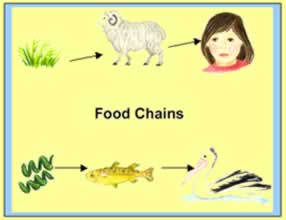Caterpillars eat plants and get the food the plant made into their bodies. Caterpillars are known as first order consumers. Birds that do not eat plants will then eat the caterpillar and in turn get the plant food into their bodies. Birds are known as second order consumers. The caterpillar is very important in providing food for many other creatures. Caterpillar's are responsible for supplying the sun's energy, trapped in the plant food, to the birds and in turn any other animal, third order consumer, such as a cat, that eats the bird.

Animals that come just after plants in a food chain are called herbivores. Herbivores are animals that eat only plants. After the herbivores come the carnivores which eat other animals. Only 10% of the energy from one level will flow to the next level. The remaining energy is lost, mainly as heat.
At the end of every food chain there are the minute organisms we call decomposers(bacteria and fungi). These small creatures breakdown the dead matter and return it to the soil for use by other growing animals and plants. Decomposition normally involves the use of oxygen to break down the organic matter However there are bacteria and fungi that can decompose organic matter in the absence of oxygen.
Discuss what the Earth would be like if decomposers were to all suddenly die.
Why do all food chains start with a producer?
What flows from one organism to the next in a food chain?
What type of consumer is the sheep in the food chain above?
If the algae eaten by a fish contain 100 joules of energy what is the number of fish that must be eaten by a pelican so that the pelican gets 100 joules of energy?